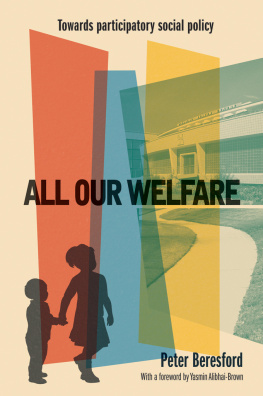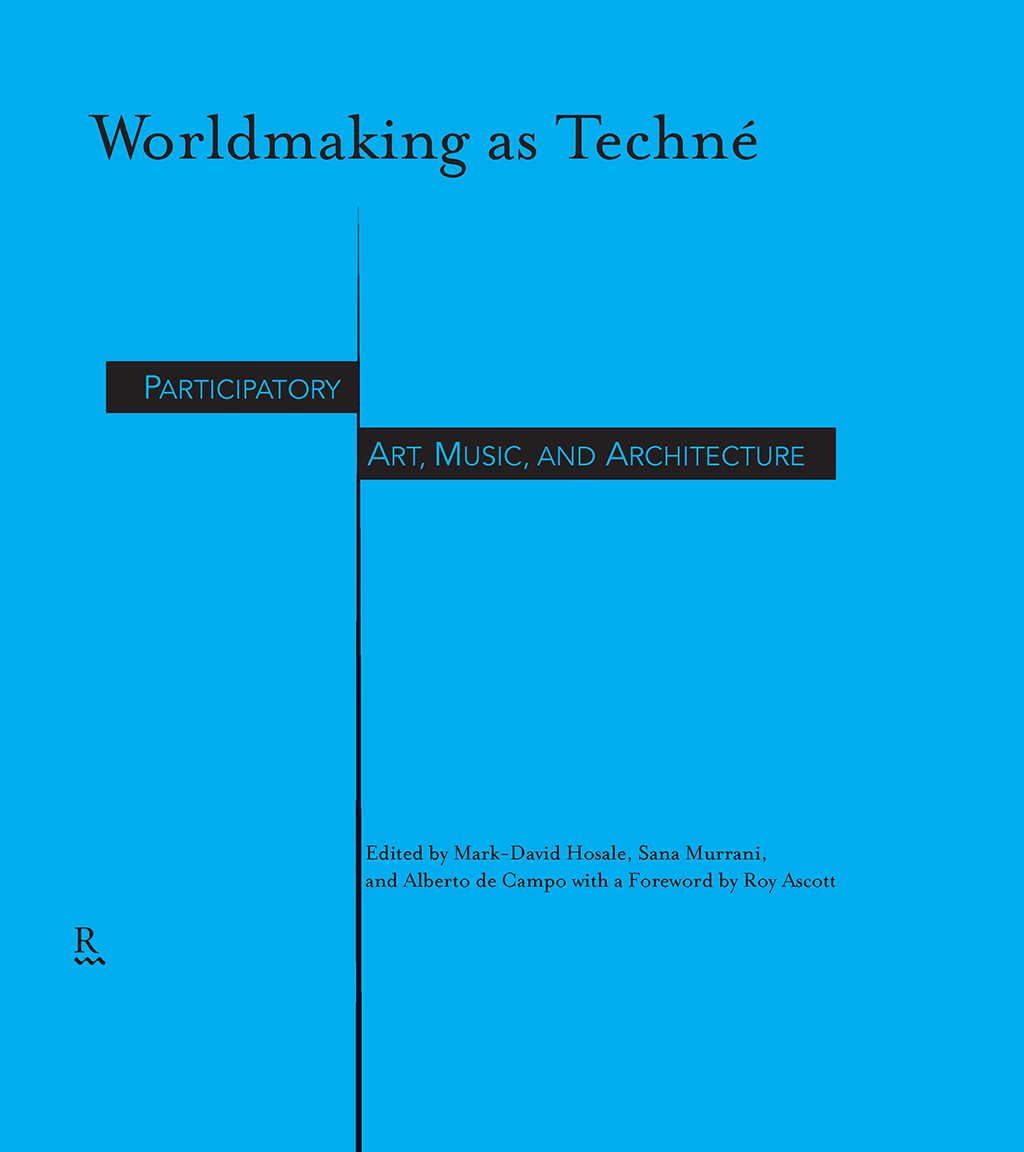Worldmaking as Techn: Participatory Art, Music, and Architecture
Editors: Mark-David Hosale, Sana Murrani, and Alberto de Campo
with a Foreword by Roy Ascott
Authors: Sofian Audry, Philip Beesley, Laura Beloff, Peter Blasser, James Coupe, Alberto de Campo, Heinz von Foerster, Felix Guattari, Mark-David Hosale, Kathrine Elizabeth L. Johansson, Sang Lee, Sana Murrani, Dan Overholt, Andrew Pickering, Esben Bala Skouboe, Chris Salter, Nicolas Schffer, Edward Shanken, Graham Wakefield
Library and Archives Canada Cataloguing in Publication
Worldmaking as techn: participatory art, music, and architecture / edited
by Mark-David Hosale, Sana Murrani and Alberto de Campo; with a foreword
by Roy Ascott.
Includes bibliographical references and index.
ISBN 978-1-988366-09-8 (hardcover)
1. Interactive art. 2. Arts--Philosophy. I. Hosale, Mark-David, author, editor
II. Murrani, Sana, author, editor III. Campo, Alberto de, author, editor
N7433.915.W67 2017 700.1 C2017-901068-9
Cover and Book design: Mark-David Hosale
Production: Salvador Miranda and Lorena Almaraz
Printing by Regal Printing
Hong Kong, China
E-book by Bulaja Naklada
Zagreb, Croatia
This book is set in Avenir, Symbol, Times New Roman, and Mrs. Eaves Roman
Copyright 2018 Riverside Architectural Press
All rights reserved by the individual paper authors who are solely responsible for their content. No part of this work covered by the copyright herein may be reproduced or used in any form or by any means graphic electronic, or mechanical, including photocopying, recording, taping or information storage and retrieval systems without prior permission of the copyright owner.
Every effort has been made to contact copyright holders and to ensure that all the information presented is correct. Some of the facts in this volume may be subject to debate or dispute. If proper copyright acknowledgment has not been made, or for clarifications and corrections, please contact the publishers and we will correct the information in future reprinting, if any.

From a pub in Milan...
Foreword
At the midpoint of 20 th century culture, in the slipstream of the intellectual momentum established most notably by Ross Ashby, Gregory Bateson, and Heinz von Forster, the word cybernetics was introduced into the world of art, radically affecting, over the long term, both art theory and art practice. At once a provocation and a prophesy, the word enabled the values of process and system to enter the perception and practice of artists, who were otherwise immersed in the stasis of object and structure. Indeed, the 1943 paper by Rosenblueth, Wiener, and Bigelow, Behavior, Purpose and Teleology was prescient in relation to the move in art and architecture towards behaviour concerned that not only what an artwork or building could do, but what the viewer or user can do to make it do it!
This book is essentially about doing, set in the context of technological and ontological becoming... of new forms, new behaviours, new meanings. It is a book that witnesses the triumph of theory on the move, of worlds in emergence, of the malleability of mind and matter. Such processes of perceptual plurality, the fluctuation of form, the generation of multiple meaning, calls for semantic interplay and physical interaction that have institutional and ontological consequences: institutionally, in that the technology of art demands the revisioning and restructuring of the architecture of encounter, that is the post-gallery, moistmedia museum environment; and ontologically in the reframing of thought and theory, at all levels of human encounter, whether singular and intimate or social and public.
Here we have a book that speaks of the poetry of change in sync with the technology of desire, where computational inspiration meets with the fertility of the creative organism, whether behaviourally performative or structurally adaptive, and always in the frame of advanced ontological engineering. As a consequence of the interactional element in their evolution, art and architecture, like the advanced technology to which they turn, have come to be seen, and above all created, as instruments of the individual users desire, rather than simply users of common cultural tropes, as past decades determined. The artwork, as process and system, offers interaction with multiple worlds, new universes of mind and media. Art, as we read here, has become a worldmaking process, architecture has become subtly semiotic and serially transformative.
Worldmaking necessarily involves word making: new terms of technique are required, new phrases of creation are called for, the whole vocabulary of becoming requires critical and theoretical renewal and redescription, a demand that this book celebrates in excelsis a book about worldmaking by worldmakers exhibiting not only aesthetic innovation but technological sense and social sensibility.
Roy Ascott.
Introduction from the editors
While the three editors of this volume have disparate practices that fall into the domains of art, music, and architecture, the conceptual thinking and the methodology that drives our practices transcends medium or discipline. This commonality can be traced to the foundation of technology in our work. Technology-based work is inherently interdisciplinary. Stemming from the digital, modern technology provides humankind with the ability to encode all information and its representation using the same binary system as a basis. It has a tendency to be algorithmically executed, runtime, and adaptive to change. As a result, technology-based works commonly feature notions of participation, perception, interaction, user experience, and immersion in its outcome.
Beyond the use of technology, we found common-ground in the desire to maintain a close-knit relationship between philosophy and methodology in our practice. In our work, philosophical concepts are manifested in the methods for the creation of work, as much as they are embodied in the content of work itself. In our work we see the process from creation to presentation as part of a continuum. To describe this relationship we found the term techn (). Techn is an ancient philosophical concept that has been debated by philosophers such as Aristotle, Xenophon and Plato, as well as more contemporary philosophers such as Guattari and Heidegger. In simplified terms the concept of techn is concerned with the art and craft of making, but the extended meaning implies a discussion of the significance of the work, including how and why something is made.
For Aristotle, techn (which literally means art or skill From this definition one can understand techn as a mode of rationalization capable of concept forming, and is a form of discourse in its own right.
. As an arts of the mind, techn is a key tool in the exploration of knowing (episteme), and key in the process of revealing truth:
Techn is a mode of aletheuein [getting at truth]. It reveals whatever does not bring itself forth and does not yet lie here before us, whatever can look and turn out now one way and now another. Thus what is decisive in techn does not lie at all in making and manipulating nor in the using of means, but rather in... revealing.
In Heideggers essay the need for techn is presented with some urgency. In describing our world, Heidegger states that






